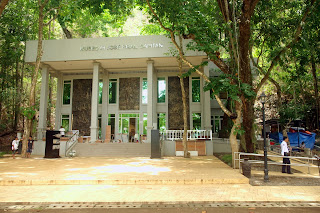Winning a lottery shortly after his arrival in Dapitan, Rizal
purchased 16 hectares of land. Out of his 4,000 pesos winnings he built
sheltering structures, developed a farm, put up a school for boys, and practiced
medicine and even treated poor local patients for free. In 1897 after Rizal was
executed his properties were confiscated by the Spanish authorities as an indemnity
to the state and transferred their custody to Don Cosme Borromeo. The site was
converted into a local park in 1913. After the Philippine independence from the
United States, the government expanded the area to 439 hectares with a buffer
zone of 15 hectares. The land covering the Rizal Shrine is a government
protected area.
 |
| The shrine is located along a bay |
Rizal Shrine occupies a terrain with hills and high
grounds along a bay. Near the gate or park’s entrance is the almost operational museum.
When fully completed, it will house memorabilia such as Rizal’s clothing, books
and other personal belongings that will be available for view to the public. In the park are paved walkways and lampposts
and trees, some of them especially those in the hilly grounds are said to be more
than a century old. Near the shore is a
large rock which is called “Mi Retiro Rock”. It is also called “Lover’s Rock”.
It is there that Rizal wrote some of his works such as “Mi Retiro” and “Himno
Talisay”. The rock was also a place where Rizal and Josephine Bracken, his
lover, often spent time together relishing their loving moments and enjoying
the breath of fresh air from the sea and watching the beautiful sunset in the
bay.
 |
| The museum |
 |
| the "Lover's Rock" |
 |
| A view of the bay from the rock |
A replica of the house of Rizal is faithfully reconstructed
right on its original site on a foot of a hill. It is made of the same indigenous
materials such as bamboo, cogon grass, rattan and hardwoods on which the
original house was built of. It has pyramid-shaped thatched roofing of cogon
grass. The walls are made of bamboo and the floorings are of woods. Timbers as
pillars and wooden posts beneath the floor support the weight of the
house. The house has verandas on each
three sides. The one facing the front also serves as the dining place where a
dining table and chairs are set. The house can be accessed on either of the two
short stairs that lead to a veranda. Inside the house are the living room and
the only bed room. A covered bridge-like structure connects a veranda to the comfort
room. Aside from Rizal, the house also accommodated Doña Josefa, Rizal’s
mother, his sisters, some of his relatives and Josephine Bracken when they came
to visit Rizal in Dapitan.
 |
| The comfort room |
Inside the house is furniture of Spanish colonial era design which is made of indigenous hardwoods. In the living room are chairs and a center table. The seat of the chairs and the top of the table are made of woven rattan that is attached to the wooden frames. There are two chests in the sides of the wall. Outside the only room is an empty book shelf, a wooden wall mounted hooks, a work table and chair and a set of two chairs with a small round table.
In the bedroom is a double sized four poster bed with mattress and white curtains around it. By the bed is a chest and a chair in the corner of the room. There is a cabinet with a mirror on one of its doors and a dresser with a small mirror on top. A chair with a raised seat pairs the dresser.
The cottage for the kitchen is outside the house. There is a stove and the kitchen utensils composed of pots and pans that are made of clay. A pipe of bamboo is reached to the sink.
Aside from the casa residencia, or the residential house, faithful replicas of the original structures which Rizal built are also reconstructed. There is the casitas de salud, a pair of two huts, one for male and the other for female that served as a dormitory for out of town patients. There is the casa redonda or round house. This cottage on stilt is not round but rather octagonal in shape. It was there that Rizal conducted an eye surgery on George Taufer, the adoptive father of Josephine Bracken and on Doña Josefa, his mother. There is the Casa cuadrada or square house which was built as a workshop and secondary dormitory for Rizal’s students. And there is the chicken coop or hen house which perched on a slope near Rizal’s house.
 |
| Casitas de Salud |
 |
| Casa Redonda |


























No comments:
Post a Comment